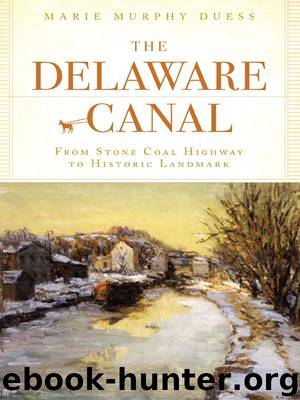The Delaware Canal by Marie Murphy Duess

Author:Marie Murphy Duess
Language: eng
Format: epub, mobi
Publisher: The History Press
Published: 2012-03-25T16:00:00+00:00
Boats on the canal were called snappers, stiff boats, packers, flickers, chunkers and scows, but they should never be called barges since, unlike barges, the boats on the Delaware Canal had steering mechanisms that the boatmen used with great skill. Courtesy of Historic Langhorne Association.
Arks were costly—especially to the forests surrounding Mauch Chunk—since they could not make a return trip upriver. The five-man crew that navigated the arks downriver returned to Mauch Chunk by foot, carrying the nails and joints with them so that they could be used for new vessels. According to Michael Knies’s book, Coal on the Lehigh, as many as thirteen men built twelve arks of six or seven sections in one week.
There were also boats called “flickers” that were used before the Delaware Canal was built. R. Francis Rapp, who built boats in Erwinna from 1858 to 1882, tells us in “Lehigh and Delaware Division Canal Notes”:
After the Lehigh canal was built, a smaller boat, called a “Flicker” was used, these were let out of the canal at an outlet lock at Easton into the Delaware River and floated down as far as Bordentown, where they entered the Delaware and Raritan canal by an inlet lock and proceeded thence to New York. This could only happen at reasonably high water and was impossible at low water…These so called flicker boats were only used before the building of the Delaware Division canal, after which the present day canal boats were used and the flickers given up.48
Soon, a new kind of boat would become the standard for transporting goods and products to Philadelphia, one that wouldn’t need to fight the currents and navigate the falls.
Canalboats
With the conversion of the Lehigh Navigation and the Delaware Division Canal into a two-way system, allowing boats to travel upstream as easily as downstream, and the decrease in lumber due to the denuded forests, the arks that were being used had to be redesigned. The new boats were constructed to fit through the many locks along both systems. The eleven-foot width of the locks on the Delaware Canal dictated that the boat be no wider than ten and a half feet.
Before long, boatyards sprouted up along the canal, from Bristol to Easton. The new boats were diverse, and they were called by different names, sometimes humorous, often after heroes and virtues—names such as Sabbath Rest, the To and Fro, May Flour, Ladies Friend and Star of Bethlehem. The Molly-Polly-Chunker was made famous in the ending years of the canal age when a group of people that included Louis Tiffany made a trip to Mauch Chunk from Bristol. There were packers (built by Asa Packer), flickers, chunkers (any boat built in Mauch Chunk), stiff boats, bullheads, scows and hinge boats, and there was even a “beer” boat. But make note: there were no barges. It is important that we understand, when discussing the Pennsylvania canals, that the vessels used to transport coal, lumber, ore and produce were not barges.
According to Lance Metz of the National Canal Museum:
It’s an insult to the people who piloted the boats.
Download
This site does not store any files on its server. We only index and link to content provided by other sites. Please contact the content providers to delete copyright contents if any and email us, we'll remove relevant links or contents immediately.
The Vikings: Conquering England, France, and Ireland by Wernick Robert(79821)
Ali Pasha, Lion of Ioannina by Eugenia Russell & Eugenia Russell(40081)
The Conquerors (The Winning of America Series Book 3) by Eckert Allan W(36938)
The Vikings: Discoverers of a New World by Wernick Robert(36889)
Cecilia; Or, Memoirs of an Heiress — Volume 1 by Fanny Burney(32375)
Cecilia; Or, Memoirs of an Heiress — Volume 3 by Fanny Burney(31750)
Cecilia; Or, Memoirs of an Heiress — Volume 2 by Fanny Burney(31715)
Empire of the Sikhs by Patwant Singh(22907)
The Secret History by Donna Tartt(18744)
Hans Sturm: A Soldier's Odyssey on the Eastern Front by Gordon Williamson(18431)
Cat's cradle by Kurt Vonnegut(15094)
Pimp by Iceberg Slim(14213)
Sapiens: A Brief History of Humankind by Yuval Noah Harari(14165)
Talking to Strangers by Malcolm Gladwell(13134)
Norse Mythology by Gaiman Neil(13125)
Leonardo da Vinci by Walter Isaacson(13105)
4 3 2 1: A Novel by Paul Auster(12214)
Underground: A Human History of the Worlds Beneath Our Feet by Will Hunt(11980)
The Radium Girls by Kate Moore(11867)
